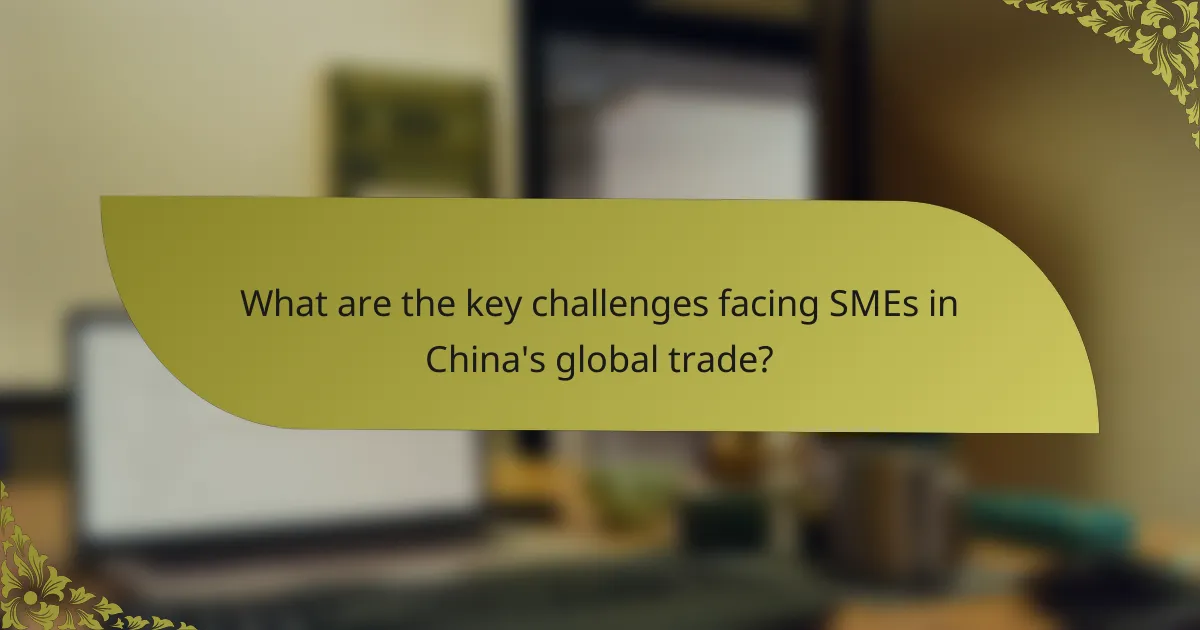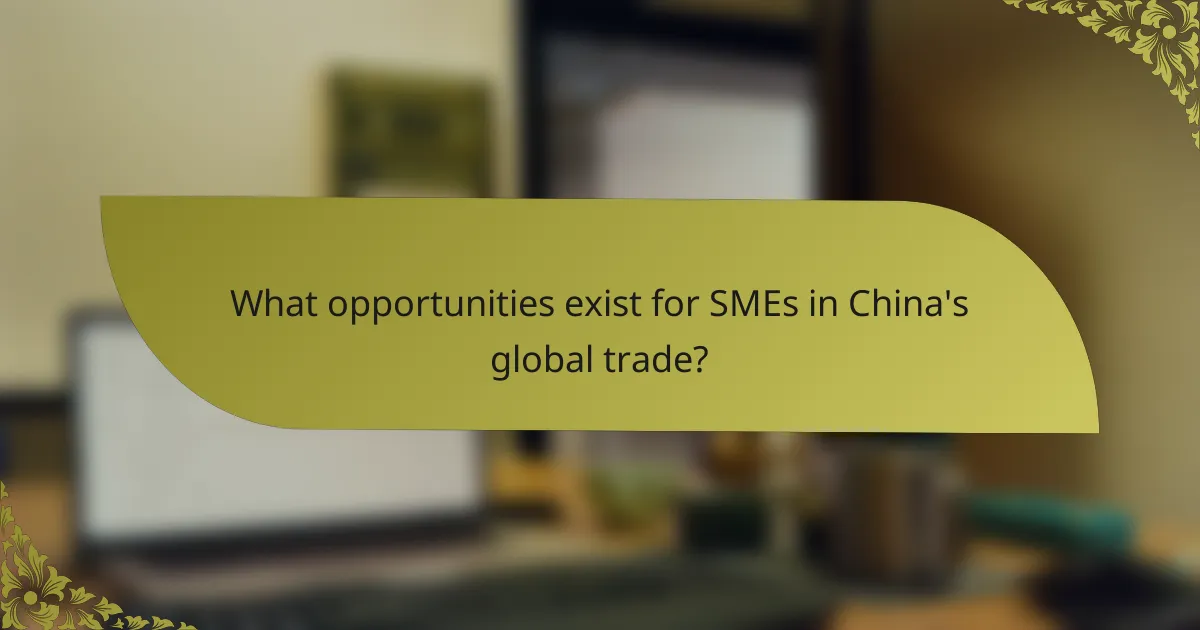Small and Medium Enterprises (SMEs) in China face significant challenges in global trade, including access to finance, regulatory compliance, and intense market competition. Approximately 60% of SMEs report difficulties in securing loans, while navigating complex international regulations adds to their burdens. Despite these obstacles, SMEs have substantial opportunities to expand internationally through China’s trade agreements and initiatives like the Belt and Road Initiative. E-commerce platforms enable them to reach global customers, and government support programs offer resources for international growth. By adopting strategic planning and leveraging technology, SMEs can effectively address challenges and capitalize on emerging opportunities in the global market.

What are the key challenges facing SMEs in China’s global trade?
Key challenges facing SMEs in China’s global trade include access to finance, regulatory compliance, and market competition. Access to finance remains a significant hurdle, as many SMEs struggle to secure loans. According to the World Bank, about 60% of SMEs in China report facing financing difficulties. Regulatory compliance is complex, with varying international standards that SMEs must navigate. Additionally, market competition is fierce, with both local and international players vying for market share. This competition can pressure profit margins and limit growth opportunities for SMEs.
How do regulatory policies impact SMEs in global trade?
Regulatory policies significantly impact SMEs in global trade by shaping their operational environment. These policies dictate trade tariffs, import/export restrictions, and compliance requirements. For instance, high tariffs can increase costs for SMEs, limiting their competitiveness in foreign markets. Conversely, favorable trade agreements can facilitate easier market access for these businesses. Regulatory compliance can also require SMEs to invest in resources for adherence, which may strain their finances. Research by the World Bank indicates that SMEs often face higher relative costs of compliance compared to larger firms, which can hinder their growth in international markets. Thus, regulatory policies can either pose challenges or create opportunities for SMEs in global trade.
What specific regulations pose the greatest challenges?
Trade regulations and compliance requirements pose significant challenges for SMEs in China’s global trade. These regulations include tariffs, import/export restrictions, and complex customs procedures. SMEs often lack the resources to navigate these regulations effectively. Additionally, stringent quality standards and certification requirements can hinder market entry. Intellectual property regulations also present obstacles, as SMEs may struggle to protect their innovations. According to a report by the World Bank, 50% of SMEs cite regulatory compliance as a major barrier to international trade. Overall, these specific regulations create a challenging environment for SMEs looking to expand globally.
How do trade tariffs affect SMEs’ competitiveness?
Trade tariffs negatively impact SMEs’ competitiveness by increasing operational costs. Higher tariffs lead to increased prices for imported raw materials and components. This raises production costs for small and medium-sized enterprises. Consequently, SMEs may struggle to maintain competitive pricing against larger firms. Additionally, tariffs can limit access to foreign markets for SMEs. This reduces their potential customer base and revenue opportunities. Research shows that SMEs are more sensitive to cost increases than larger corporations. A study by the OECD indicates that tariffs disproportionately affect smaller businesses. This can hinder their growth and innovation capabilities in the global market.
What financial obstacles do SMEs encounter in global trade?
SMEs encounter several financial obstacles in global trade. Limited access to financing is a primary challenge. Many SMEs struggle to secure loans due to insufficient collateral or credit history. This results in reduced ability to invest in international expansion. Currency fluctuations also pose significant risks for SMEs. These fluctuations can affect profit margins and pricing strategies. Additionally, high transaction costs can deter SMEs from entering global markets. These costs include shipping, tariffs, and compliance with foreign regulations. According to a report by the World Bank, SMEs represent 90% of businesses and over 50% of employment globally, yet they face disproportionate financial barriers compared to larger firms.
How do funding limitations restrict growth opportunities?
Funding limitations restrict growth opportunities by hindering access to essential resources. Insufficient capital prevents small and medium-sized enterprises (SMEs) from investing in technology and innovation. Without investment, SMEs struggle to enhance productivity and efficiency. Limited funding also restricts marketing efforts, reducing brand visibility in global markets. Additionally, funding constraints can delay expansion plans, such as entering new markets or scaling operations. According to a report by the World Bank, 40% of SMEs in China cite access to finance as a significant barrier to growth. This lack of financial support ultimately stifles competitiveness and reduces potential revenue streams.
What are the implications of currency fluctuations for SMEs?
Currency fluctuations can significantly impact SMEs by affecting their pricing, costs, and competitiveness. When a currency depreciates, imported goods become more expensive. This can lead to increased production costs for SMEs reliant on foreign materials. Conversely, a stronger currency can make exports more expensive, potentially reducing demand in international markets.
SMEs may face challenges in budgeting and forecasting due to unpredictable currency movements. This uncertainty can hinder investment decisions and financial planning. Additionally, fluctuating exchange rates can affect profit margins, especially for businesses engaged in international trade.
According to a report by the International Trade Centre, 40% of SMEs cite currency volatility as a major barrier to exporting. This statistic underscores the importance of understanding currency risks in global trade.
How does market access affect SMEs in China’s global trade?
Market access significantly influences SMEs in China’s global trade. It determines their ability to enter international markets. Enhanced market access allows SMEs to expand their customer base beyond domestic borders. This expansion can lead to increased sales and revenue growth.
Conversely, limited market access restricts SMEs from competing globally. It can hinder their growth potential and innovation capabilities. According to the World Bank, SMEs contribute to over 60% of China’s GDP. Access to international markets is crucial for their sustainability and competitiveness.
Furthermore, trade agreements can facilitate better market access for SMEs. For instance, the Regional Comprehensive Economic Partnership (RCEP) aims to reduce trade barriers. This agreement can enhance the export opportunities for Chinese SMEs.
Overall, market access plays a vital role in shaping the global trade landscape for SMEs in China.
What barriers exist for SMEs entering foreign markets?
Barriers for SMEs entering foreign markets include high costs, regulatory challenges, and cultural differences. High costs encompass expenses related to market research, legal compliance, and distribution. Regulatory challenges often involve navigating complex import/export laws and tariffs. Cultural differences can hinder effective communication and marketing strategies. According to a survey by the World Bank, 70% of SMEs cite regulatory compliance as a significant barrier. Additionally, SMEs may lack the resources to adapt to local market conditions, which can further impede their success.
How do cultural differences create challenges for SMEs?
Cultural differences create challenges for SMEs by affecting communication and collaboration. Misunderstandings can arise from diverse languages and expressions. Different cultural norms influence business practices and expectations. For instance, negotiation styles vary significantly across cultures. These differences may lead to conflicts or delays in decision-making. Additionally, varying attitudes toward hierarchy can impact team dynamics. Research shows that 70% of SMEs face issues related to cultural misunderstandings in international markets. Adapting to these cultural differences is essential for successful global trade operations.

What opportunities exist for SMEs in China’s global trade?
SMEs in China have significant opportunities in global trade. They can access a vast international market due to China’s trade agreements. The Belt and Road Initiative enhances connectivity and trade routes for SMEs. E-commerce platforms allow SMEs to reach global customers easily. Government support programs provide funding and resources for international expansion. Participation in trade fairs helps SMEs showcase their products worldwide. The growing demand for unique and niche products offers SMEs a competitive edge. Lastly, collaboration with foreign partners can lead to knowledge exchange and innovation.
How can SMEs leverage technology to enhance global trade?
SMEs can leverage technology to enhance global trade by utilizing digital platforms for market access. Online marketplaces allow SMEs to reach international customers efficiently. E-commerce tools simplify the sales process and reduce operational costs. Cloud-based solutions enable better collaboration and communication across borders. Data analytics helps SMEs understand market trends and customer preferences. Furthermore, digital payment systems facilitate secure transactions globally. According to a report by the International Trade Centre, 75% of SMEs that adopted digital tools increased their export activities. This demonstrates that technology adoption directly correlates with improved global trade performance for SMEs.
What digital tools are most beneficial for SMEs?
Cloud computing platforms such as Microsoft Azure and Amazon Web Services are highly beneficial for SMEs. These tools provide scalable resources that can adapt to business needs. They enable SMEs to store and analyze data efficiently. Project management tools like Trello and Asana enhance team collaboration and task tracking. These tools improve productivity and project visibility. Customer relationship management (CRM) systems such as Salesforce help SMEs manage customer interactions effectively. They facilitate better customer service and retention. E-commerce platforms like Shopify enable SMEs to reach global markets easily. They simplify online selling and payment processing. Digital marketing tools such as Google Ads and social media platforms enhance brand visibility. They allow SMEs to target specific audiences effectively. Overall, these digital tools empower SMEs to compete in global trade efficiently.
How does e-commerce open new markets for SMEs?
E-commerce opens new markets for SMEs by providing access to a global customer base. It eliminates geographical barriers, allowing small businesses to reach consumers worldwide. Online platforms enable SMEs to showcase their products without the need for a physical storefront. This reduces overhead costs and increases affordability for market entry. Additionally, e-commerce offers various marketing tools to target specific demographics effectively. According to a report by the International Trade Centre, 70% of SMEs reported increased sales through online channels. This statistic underscores the potential of e-commerce in expanding market reach for small enterprises.
What role do partnerships play in expanding SMEs’ reach?
Partnerships play a crucial role in expanding SMEs’ reach. They facilitate access to new markets and customers. Collaborating with larger firms can enhance visibility and credibility. Strategic alliances can provide shared resources and expertise. Partnerships often lead to improved supply chain efficiency. They can also enable knowledge sharing and innovation. According to a study by the World Bank, SMEs that engage in partnerships grow 20% faster than those that do not. This growth is often attributed to increased market access and competitive advantages gained through collaboration.
How can collaborations with larger firms benefit SMEs?
Collaborations with larger firms can benefit SMEs by providing access to resources and expertise. Larger firms often have established networks and distribution channels. This can enhance the market reach of SMEs significantly. Additionally, collaborations can lead to shared technology and innovation. SMEs can leverage the research and development capabilities of larger firms. Financial support from larger firms can also improve the cash flow of SMEs. According to a study by the World Bank, partnerships can increase SMEs’ competitiveness in global markets. This demonstrates the tangible advantages of such collaborations.
What networking strategies can SMEs adopt for growth?
SMEs can adopt several networking strategies for growth. Establishing partnerships with other businesses can enhance resource sharing and market access. Participating in industry associations offers networking opportunities and knowledge exchange. Utilizing social media platforms helps SMEs connect with potential clients and partners efficiently. Attending trade shows allows SMEs to showcase products and meet industry stakeholders. Engaging in local community events fosters relationships and brand visibility. Collaborating with influencers can increase brand awareness and reach. Leveraging online networking platforms expands connections beyond geographical limitations. These strategies collectively contribute to the growth and sustainability of SMEs in competitive markets.
What emerging markets present opportunities for SMEs?
Emerging markets that present opportunities for SMEs include Southeast Asia, Africa, and Latin America. Southeast Asia boasts a growing middle class and increasing digital adoption. Countries like Vietnam and Indonesia show significant economic growth rates. Africa has a youthful population and rapid urbanization, creating demand for various products and services. Nations such as Nigeria and Kenya are leading in technology and innovation. Latin America offers access to diverse markets, with Brazil and Mexico being key players. These regions are experiencing economic reforms and increased foreign investment. The World Bank reported that SMEs in these markets can benefit from improved infrastructure and trade agreements.
Which regions are showing growth potential for SMEs?
Southeast Asia is showing significant growth potential for SMEs. The region has experienced rapid economic development and increasing digital adoption. Countries like Vietnam, Indonesia, and Thailand are leading this trend. Vietnam’s GDP growth rate reached 6.5% in 2022, indicating a strong market for small businesses. Indonesia has a large consumer base, with over 270 million people, driving demand for various products and services. Thailand’s government initiatives support SMEs through funding and resources. Furthermore, the ASEAN Economic Community promotes regional trade, enhancing opportunities for SMEs across member states.
How can SMEs identify and target new customer segments?
SMEs can identify and target new customer segments by conducting market research and analyzing customer data. Market research helps SMEs understand market trends and consumer behavior. Surveys and focus groups can provide insights into customer preferences. Analyzing existing customer data reveals patterns and demographics. SMEs can segment customers based on age, location, and buying habits. Utilizing social media analytics can uncover emerging market trends. Additionally, SMEs can test new products or services to gauge interest in different segments. According to a study by McKinsey, companies that effectively use customer data can increase their revenue by 10% to 20%. This demonstrates the importance of data-driven strategies in targeting new customer segments.

How can SMEs effectively navigate challenges and seize opportunities in global trade?
SMEs can effectively navigate challenges and seize opportunities in global trade by adopting strategic planning and leveraging technology. Strategic planning involves understanding market dynamics and regulatory environments in target countries. This includes conducting thorough market research to identify potential demand and competition. Leveraging technology can enhance operational efficiency and reduce costs. For instance, utilizing e-commerce platforms can expand market reach beyond local boundaries.
Additionally, forming partnerships with local businesses can provide valuable insights and facilitate smoother entry into foreign markets. Accessing government resources and trade organizations can also provide support and guidance. According to the World Trade Organization, SMEs contribute significantly to global trade and economic growth, underscoring their potential in international markets. By focusing on these strategies, SMEs can better position themselves to overcome obstacles and capitalize on emerging opportunities in global trade.
What strategies can SMEs implement to overcome challenges?
SMEs can implement several strategies to overcome challenges in China’s global trade. First, they should focus on building strong supply chain relationships. Establishing reliable partnerships can enhance operational efficiency. Second, adopting digital technologies is crucial. Digital tools can streamline processes and improve market access. Third, SMEs should invest in market research. Understanding consumer preferences helps tailor products effectively. Fourth, they can leverage government support programs. Many initiatives exist to assist SMEs in international expansion. Lastly, continuous employee training is essential. Skilled employees can adapt to changing market demands. These strategies can significantly enhance SMEs’ resilience and competitiveness in global trade.
How can SMEs adapt to changing regulatory environments?
SMEs can adapt to changing regulatory environments by implementing flexible compliance strategies. They should regularly monitor regulatory updates to stay informed. Training staff on compliance requirements is essential for effective adaptation. Establishing relationships with legal experts can provide valuable insights and guidance. Utilizing technology can streamline compliance processes and reduce errors. SMEs can also engage in industry associations to share best practices. Developing a risk management plan helps prepare for potential regulatory changes. This proactive approach enhances resilience and competitiveness in the market.
What financial strategies can mitigate risks for SMEs?
Financial strategies that can mitigate risks for SMEs include diversification, cash flow management, and insurance. Diversification reduces reliance on a single revenue stream. This can stabilize income and lower vulnerability to market fluctuations. Cash flow management ensures that SMEs maintain sufficient liquidity. A study by the Small Business Administration indicates that poor cash flow is a leading cause of business failure. Insurance protects against unforeseen events, such as natural disasters or liability claims. According to the National Federation of Independent Business, 75% of small businesses have insurance to safeguard their assets. Implementing these strategies can enhance resilience and sustainability for SMEs in a competitive landscape.
What best practices should SMEs adopt for successful global trade?
SMEs should adopt several best practices for successful global trade. First, they must conduct thorough market research. Understanding local regulations, culture, and consumer preferences is crucial. Second, SMEs should develop strong partnerships with local distributors or agents. This can enhance market entry and provide valuable insights. Third, they need to ensure compliance with international trade regulations. Adhering to customs laws and tariffs can prevent costly delays. Fourth, SMEs should invest in digital tools for efficient logistics and communication. Technologies like e-commerce platforms can streamline operations. Fifth, they should focus on quality and innovation in their products. High-quality offerings can differentiate them in competitive markets. Lastly, SMEs must continuously monitor and adapt to market changes. Flexibility can help them respond to new challenges and opportunities.
How can SMEs enhance their marketing strategies for international markets?
SMEs can enhance their marketing strategies for international markets by conducting thorough market research. Understanding local consumer behavior is crucial. Tailoring marketing messages to fit cultural contexts improves engagement. Utilizing digital marketing channels can expand reach effectively. Collaborating with local partners can provide valuable insights and networks. Implementing data analytics helps in measuring campaign effectiveness. Offering localized products or services can meet specific market needs. These strategies have been shown to increase market [censured] and customer loyalty.
What role does continuous learning play in SMEs’ success in global trade?
Continuous learning is vital for SMEs’ success in global trade. It enables them to adapt to changing market dynamics and consumer preferences. SMEs that engage in continuous learning can enhance their competitive edge. They gain insights into new technologies and innovative practices. This knowledge helps them improve product quality and operational efficiency. Furthermore, continuous learning fosters cultural awareness and understanding of international markets. Research indicates that businesses prioritizing learning achieve 37% higher productivity. This statistic underscores the direct correlation between learning and success in global trade. Thus, continuous learning is essential for SMEs aiming to thrive internationally.
The main entity of the article is SMEs (Small and Medium-sized Enterprises) in China’s global trade. The article outlines the key challenges these SMEs face, including access to finance, regulatory compliance, and market competition, which hinder their growth and competitiveness. It also examines the impact of regulatory policies, trade tariffs, and financial obstacles on SMEs, while highlighting opportunities such as e-commerce, technology adoption, and emerging markets. Additionally, the article discusses strategies for SMEs to navigate challenges and leverage partnerships for expansion in the global trade landscape.



